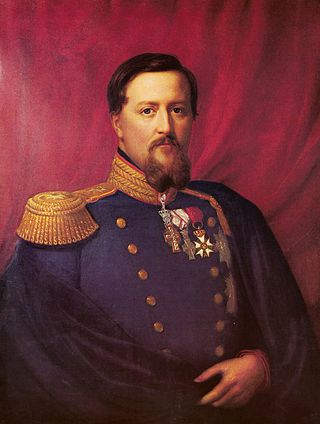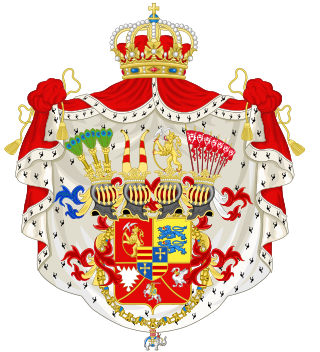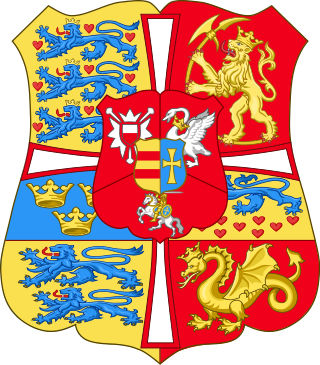
Christian VIII was King of Denmark from 1839 to 1848 and, as Christian Frederick, King of Norway in 1814.

Frederik VIII was King of Denmark from 29 January 1906 until his death in 1912.

Frederick VII was King of Denmark from 1848 to 1863. He was the last Danish monarch of the older Royal branch of the House of Oldenburg and the last king of Denmark to rule as an absolute monarch. During his reign, he signed a constitution that established a Danish parliament and made the country a constitutional monarchy. Frederick's motto was Folkets Kærlighed, min Styrke.

Frederick IV was King of Denmark and Norway from 1699 until his death. Frederick was the son of Christian V of Denmark-Norway and his wife Charlotte Amalie of Hesse-Kassel.

Frederick V was King of Denmark and Norway and Duke of Schleswig-Holstein from 6 August 1746 until his death in 1766. A member of the House of Oldenburg, he was the son of Christian VI of Denmark and Sophie Magdalene of Brandenburg-Kulmbach.

The House of Schleswig-Holstein-Sonderburg-Glücksburg, also known by its short name as the House of Glücksburg, is the senior surviving branch of the German House of Oldenburg, one of Europe's oldest royal houses. Oldenburg house members have reigned at various times in Denmark, Norway, Sweden, Iceland, Greece, several northern German states, Russia and the United Kingdom. It takes its name from the family seat in Glücksburg, a small town in Schleswig-Holstein, Germany.

Flora Danica is a comprehensive atlas of botany from the Age of Enlightenment, containing folio-sized pictures of all the wild plants native to Denmark, in the period from 1761 to 1883.

The House of Oldenburg is a German dynasty whose members rule or have ruled in Denmark, Iceland, Greece, Norway, Russia, Sweden, the United Kingdom, Livonia, Schleswig, Holstein, and Oldenburg. The current kings of Norway and the United Kingdom are patrilineal descendants of the Glücksburg branch of this house.

Rosenborg Castle is a renaissance castle located in Copenhagen, Denmark. The castle was originally built as a country summerhouse in 1606 and is an example of Christian IV's many architectural projects. It was built in the Dutch Renaissance style, typical of Danish buildings during this period, and has been expanded several times, finally evolving into its present condition by the year 1624. Architects Bertel Lange and Hans van Steenwinckel the Younger are associated with the structural planning of the castle.

Frederiksborg Castle is a palatial complex in Hillerød, Denmark. It was built as a royal residence for King Christian IV of Denmark-Norway in the early 17th century, replacing an older castle acquired by Frederick II and becoming the largest Renaissance residence in Scandinavia. On three islets in the Slotssøen, it is adjoined by a large formal garden in the Baroque style.

The Order of the Elephant is a Danish order of chivalry and is Denmark's highest-ranked honour. It has origins in the 15th century, but has officially existed since 1693, and since the establishment of constitutional monarchy in 1849, is now almost exclusively used to honour royalty and heads of state.

Danish Crown Regalia are the symbols of the Danish monarchy. They consist of three crowns, a sceptre, globus cruciger, the sword of state and an ampulla . The Danish Royal Regalia are kept in the treasury at Rosenborg Castle. The oldest of these is Christian III's sword of state from 1551. They further include King Christian IV's diamond; pearl- and gold-embroidered saddles; objects carved from ivory and rock-crystal; lapidary pieces of precious stones, and brooches in the form of fantastic animals.

Louise Augusta of Denmark and Norway was the daughter of the Queen of Denmark-Norway, Caroline Matilda of Great Britain. Though officially regarded as the daughter of King Christian VII, it is widely accepted that her biological father was Johann Friedrich Struensee, the king's royal physician and de facto regent of the country at the time of her birth. She was referred to sometimes as "la petite Struensee"; this did not, however, have any effect on her position.

Rosenborg Castle Gardens is the oldest and most visited park in central Copenhagen, Denmark. Established in the early 17th century as the private gardens of King Christian IV's Rosenborg Castle, the park also contains several other historical buildings, including Rosenborg Barracks, home to the Royal Guards, as well as a high number of statues and monuments. The park also holds art exhibitions and other events such as concerts in the summer.
Events from the year 1901 in Denmark.

Christian Gottlieb Vilhelm Bissen was a Danish sculptor. He was also a professor at the Royal Danish Academy of Fine Arts with great influence on the next generation of Danish sculptors and for a while served as its director. Bissen was trained in the Neoclassical tradition from Bertel Thorvaldsen but after a stay in Paris around 1880, he was influenced by Naturalism. With the equestrian statue of Absalon he turned to Neo-romanticism.
Fairy cup legends are folk and other tales usually relating to the theft of a "fairy cup", sometimes in the form of a drinking horn, usually from a "fairy mound". The legends are found in northwestern Europe.

The Rose Flower Cup is a large silver-gilt communal drinking vessel, with two handles and a detached lid, holding six litres and weighting almost 6 kilograms (13 lb), presented to the later King Christian IV of Denmark at his christening in 1577 by his godfather Hans Skovgaard and his wife Anne Parsberg. The name refers to a verse inscribed on the exterior of the vessel. It is now in the collection of the National Museum of Denmark.

The Crown of Christian IV, created for the coronation of Christian IV of Denmark-Norway, on 29 August 1596, is the older of the two surviving crowns of Denmark. Only used for one more coronation, that of his son, Frederick III, in 1648, it is together with the other Danish crown jewels now on display in the Royal Danish Treasury at Rosenborg Castle.





















